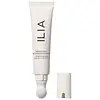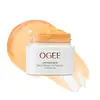What's inside
What's inside
 Key Ingredients
Key Ingredients

 Benefits
Benefits

 Concerns
Concerns

 Ingredients Side-by-side
Ingredients Side-by-side

Water
Skin ConditioningCaprylic/Capric Triglyceride
MaskingPersea Gratissima Oil
Skin ConditioningPropanediol
SolventGlycerin
HumectantPentylene Glycol
Skin ConditioningCetearyl Alcohol
EmollientCandelilla/Jojoba/Rice Bran Polyglyceryl-3 Esters
EmulsifyingJojoba Oil/Macadamia Seed Oil Esters
Skin ConditioningBrassica Campestris/Aleurites Fordi Oil Copolymer
Skin ConditioningSilica
AbrasiveGlyceryl Stearate
EmollientSodium Polyacryloyldimethyl Taurate
Emulsion StabilisingBehenyl Alcohol
EmollientCaffeine
Skin ConditioningMoringa Oil/Hydrogenated Moringa Oil Esters
Skin ConditioningSodium Stearoyl Lactylate
EmulsifyingMica
Cosmetic ColorantHydroxyacetophenone
AntioxidantCaprylyl Glycol
Emollient1,2-Hexanediol
Skin ConditioningSqualene
EmollientCaprylic/Capric/Succinic Triglyceride
EmollientXanthan Gum
EmulsifyingCitric Acid
BufferingSodium Phytate
Phytosteryl Macadamiate
Skin ConditioningPersea Gratissima Fruit Extract
EmollientCrithmum Maritimum Extract
Skin ConditioningPhytosterols
Skin ConditioningTocopherol
AntioxidantAcetyl Hexapeptide-8
HumectantSodium Citrate
BufferingCI 77891
Cosmetic ColorantCI 77491
Cosmetic ColorantWater, Caprylic/Capric Triglyceride, Persea Gratissima Oil, Propanediol, Glycerin, Pentylene Glycol, Cetearyl Alcohol, Candelilla/Jojoba/Rice Bran Polyglyceryl-3 Esters, Jojoba Oil/Macadamia Seed Oil Esters, Brassica Campestris/Aleurites Fordi Oil Copolymer, Silica, Glyceryl Stearate, Sodium Polyacryloyldimethyl Taurate, Behenyl Alcohol, Caffeine, Moringa Oil/Hydrogenated Moringa Oil Esters, Sodium Stearoyl Lactylate, Mica, Hydroxyacetophenone, Caprylyl Glycol, 1,2-Hexanediol, Squalene, Caprylic/Capric/Succinic Triglyceride, Xanthan Gum, Citric Acid, Sodium Phytate, Phytosteryl Macadamiate, Persea Gratissima Fruit Extract, Crithmum Maritimum Extract, Phytosterols, Tocopherol, Acetyl Hexapeptide-8, Sodium Citrate, CI 77891, CI 77491
Aloe Barbadensis Leaf Juice
Skin ConditioningSimmondsia Chinensis Seed Oil
EmollientBehenyl Alcohol
EmollientGlycerin
HumectantLactobacillus Ferment
Skin ConditioningCoco-Caprylate
EmollientCetearyl Alcohol
EmollientCoco-Caprylate/Caprate
EmollientPropanediol
SolventMicrocrystalline Cellulose
AbsorbentMaltodextrin
AbsorbentGlyceryl Stearate Se
EmulsifyingPalmitic Acid
EmollientSodium Hyaluronate
HumectantHydrogenated Lecithin
EmulsifyingLactobacillus
Skin ConditioningSodium Stearoyl Glutamate
CleansingPhenethyl Alcohol
MaskingAlcohol
AntimicrobialButyrospermum Parkii Butter Extract
Skin ConditioningCellulose Gum
Emulsion StabilisingAcmella Oleracea Extract
Skin ProtectingCocos Nucifera Fruit Extract
EmollientFicus Carica Bud Extract
Skin ConditioningSodium Phytate
Sodium Hydroxide
BufferingPyrus Sorbus Bud Extract
AstringentMelia Azadirachta Flower Extract
Skin ConditioningMelia Azadirachta Leaf Extract
Skin ConditioningCurcuma Longa Root Extract
MaskingOcimum Sanctum Leaf Extract
Skin ConditioningTocopherol
AntioxidantChamomilla Recutita Flower Extract
MaskingCalendula Officinalis Flower Extract
MaskingOcimum Basilicum Flower/Leaf Extract
TonicCorallina Officinalis Extract
Skin ConditioningCucumis Sativus Fruit Extract
EmollientBakuchiol
AntimicrobialAstaxanthin
Skin ConditioningHelianthus Annuus Seed Oil
EmollientLactic Acid
BufferingAloe Barbadensis Leaf Juice, Simmondsia Chinensis Seed Oil, Behenyl Alcohol, Glycerin, Lactobacillus Ferment, Coco-Caprylate, Cetearyl Alcohol, Coco-Caprylate/Caprate, Propanediol, Microcrystalline Cellulose, Maltodextrin, Glyceryl Stearate Se, Palmitic Acid, Sodium Hyaluronate, Hydrogenated Lecithin, Lactobacillus, Sodium Stearoyl Glutamate, Phenethyl Alcohol, Alcohol, Butyrospermum Parkii Butter Extract, Cellulose Gum, Acmella Oleracea Extract, Cocos Nucifera Fruit Extract, Ficus Carica Bud Extract, Sodium Phytate, Sodium Hydroxide, Pyrus Sorbus Bud Extract, Melia Azadirachta Flower Extract, Melia Azadirachta Leaf Extract, Curcuma Longa Root Extract, Ocimum Sanctum Leaf Extract, Tocopherol, Chamomilla Recutita Flower Extract, Calendula Officinalis Flower Extract, Ocimum Basilicum Flower/Leaf Extract, Corallina Officinalis Extract, Cucumis Sativus Fruit Extract, Bakuchiol, Astaxanthin, Helianthus Annuus Seed Oil, Lactic Acid
Ingredients Explained
These ingredients are found in both products.
Ingredients higher up in an ingredient list are typically present in a larger amount.
Behenyl Alcohol is a type of fatty alcohol (these are different from the drying, solvent alcohols).
Fatty Alcohols have hydrating properties and are most often used as an emollient or to thicken a product. They are usually derived from natural fats and oils; behenyl alcohol is derived from the fats of vegetable oils.
Emollients help keep your skin soft and hydrated by creating a film that traps moisture in.
In 2000, Behenyl Alcohol was approved by the US as medicine to reduce the duration of cold sores.
Learn more about Behenyl AlcoholCetearyl alcohol is a mixture of two fatty alcohols: cetyl alcohol and stearyl alcohol. It is mainly used as an emulsifier. Emulsifiers help prevent the separation of oils and products. Due to its composition, it can also be used to thicken a product or help create foam.
Cetearyl alcohol is an emollient. Emollients help soothe and hydrate the skin by trapping moisture.
Studies show Cetearyl alcohol is non-toxic and non-irritating. The FDA allows products labeled "alcohol-free" to have fatty alcohols.
This ingredient is usually derived from plant oils such as palm, vegetable, or coconut oils. There is debate on whether this ingredient will cause acne.
Due to the fatty acid base, this ingredient may not be Malassezia folliculitis safe.
Learn more about Cetearyl AlcoholGlycerin is already naturally found in your skin. It helps moisturize and protect your skin.
A study from 2016 found glycerin to be more effective as a humectant than AHAs and hyaluronic acid.
As a humectant, it helps the skin stay hydrated by pulling moisture to your skin. The low molecular weight of glycerin allows it to pull moisture into the deeper layers of your skin.
Hydrated skin improves your skin barrier; Your skin barrier helps protect against irritants and bacteria.
Glycerin has also been found to have antimicrobial and antiviral properties. Due to these properties, glycerin is often used in wound and burn treatments.
In cosmetics, glycerin is usually derived from plants such as soybean or palm. However, it can also be sourced from animals, such as tallow or animal fat.
This ingredient is organic, colorless, odorless, and non-toxic.
Glycerin is the name for this ingredient in American English. British English uses Glycerol/Glycerine.
Learn more about GlycerinPropanediol is an all-star ingredient. It softens, hydrates, and smooths the skin.
It’s often used to:
Propanediol is not likely to cause sensitivity and considered safe to use. It is derived from corn or petroleum with a clear color and no scent.
Learn more about PropanediolSodium Phytate is the synthetic salt form of phytic acid. Phytic acid is an antioxidant and can be found in plant seeds.
Sodium Phytate is a chelating agent. Chelating agents help prevent metals from binding to water. This helps stabilize the ingredients and the product.
Tocopherol (also known as Vitamin E) is a common antioxidant used to help protect the skin from free-radicals and strengthen the skin barrier. It's also fat soluble - this means our skin is great at absorbing it.
Vitamin E also helps keep your natural skin lipids healthy. Your lipid skin barrier naturally consists of lipids, ceramides, and fatty acids. Vitamin E offers extra protection for your skin’s lipid barrier, keeping your skin healthy and nourished.
Another benefit is a bit of UV protection. Vitamin E helps reduce the damage caused by UVB rays. (It should not replace your sunscreen). Combining it with Vitamin C can decrease sunburned cells and hyperpigmentation after UV exposure.
You might have noticed Vitamin E + C often paired together. This is because it is great at stabilizing Vitamin C. Using the two together helps increase the effectiveness of both ingredients.
There are often claims that Vitamin E can reduce/prevent scarring, but these claims haven't been confirmed by scientific research.
Learn more about Tocopherol